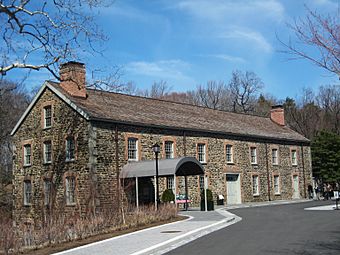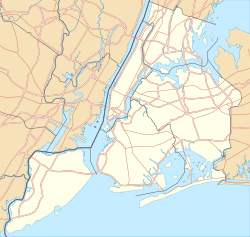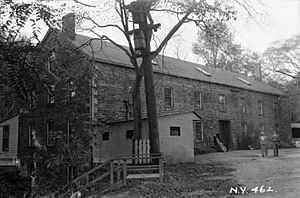Lorillard Snuff Mill facts for kids
|
Lorillard Snuff Mill
|
|
|
U.S. Historic district
Contributing property |
|

Lorillard Snuff Mill in 2011
|
|
| Location | Snuff Mill Road, New York Botanical Garden, Bronx, New York |
|---|---|
| Area | 5 acres (2.0 ha) |
| Built | 1840 |
| Architect | P. Lorillard Co. |
| Part of | New York Botanical Garden (ID67000009) |
| NRHP reference No. | 77000935 |
Quick facts for kids Significant dates |
|
| Added to NRHP | December 22, 1977 |
| Designated NHL | December 22, 1977 |
| Designated CP | May 28, 1967 |
The Lorillard Snuff Mill, now called the Lillian and Amy Goldman Stone Mill, is a very old building in the United States. It's the oldest building that was used to make tobacco products. It was built around 1840 right next to the Bronx River. The stone used for its walls came from nearby.
This special building was named a National Historic Landmark in 1977. It is located inside the New York Botanical Garden, which is also a National Historic Landmark.
Contents
History of the Lorillard Snuff Mill
The Lorillard company was started by Pierre Abraham Lorillard in 1760. After he passed away, his two sons, Peter and George, took over the business. They moved the part of the business that made products to this spot in the Bronx in 1792.
Early Days and Family Life
Peter Lorillard III built a large house with 45 rooms, a stone cottage, and stables nearby. Sadly, the big house burned down in 1923. The Lorillard family and their company moved away from the Bronx property in 1870. They moved their business to Jersey City, New Jersey.
The Mill's New Owners
In 1884, the New York City government bought the land where the mill stood. Then, in 1915, the land was given to the New York Botanical Garden. The mill itself stayed with the New York City Department of Parks and Recreation for a while. It was used for storage and workshops until 1937.
Modern Use and Restoration
Finally, in 1937, the mill was also given to the Botanical Garden. The building was updated between 1952 and 1954. A cafe and outdoor seating area were added on the side facing the Bronx River. A meeting room was created where the snuff-grinding machines used to be.
The mill had a big restoration project in 2010, costing $10.5 million. Today, the building is used for staff offices and a place for events and catering.





